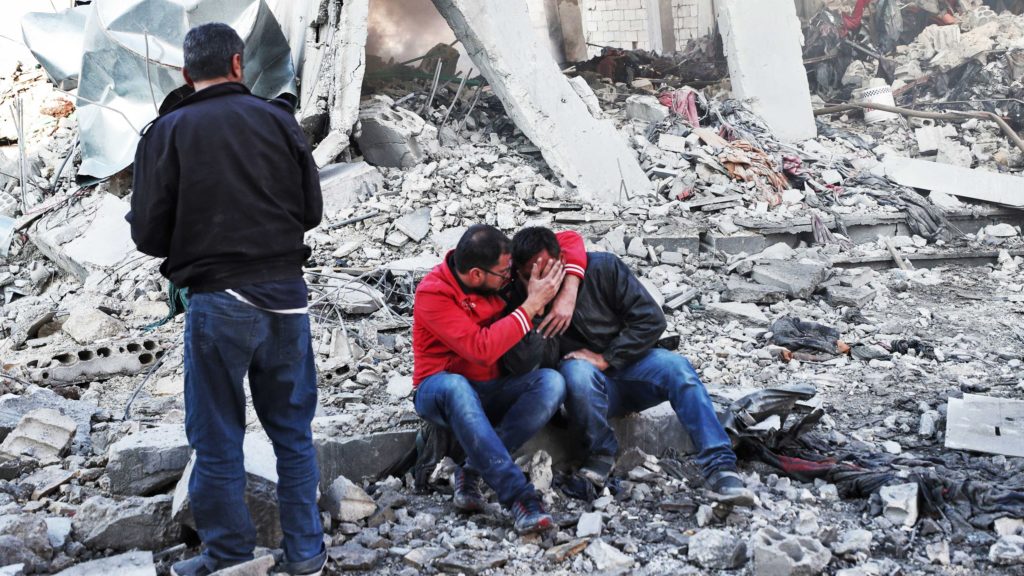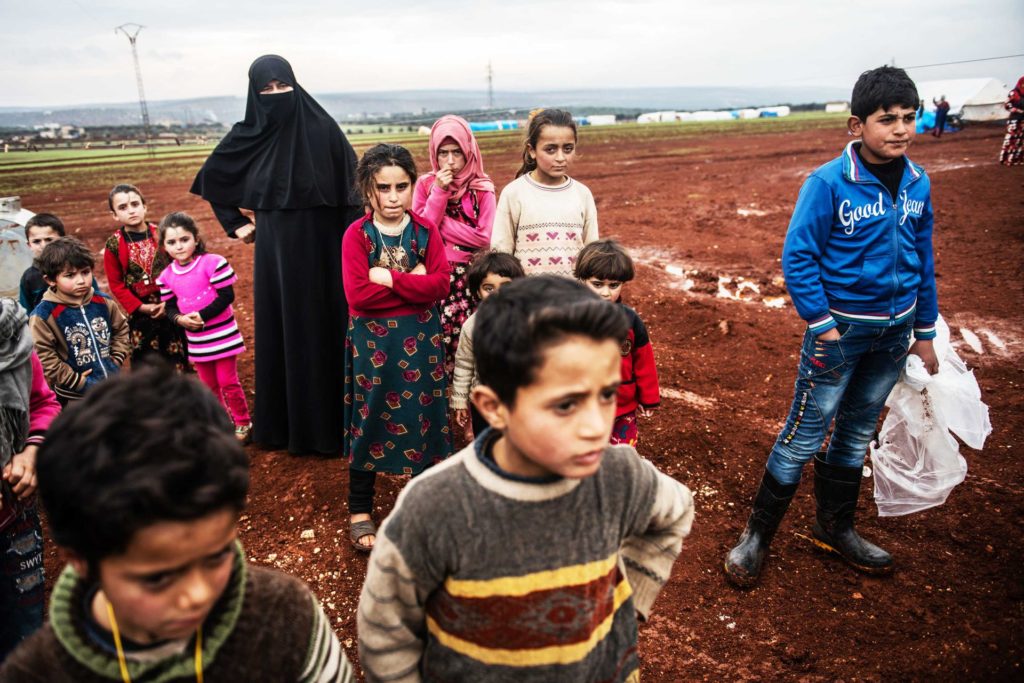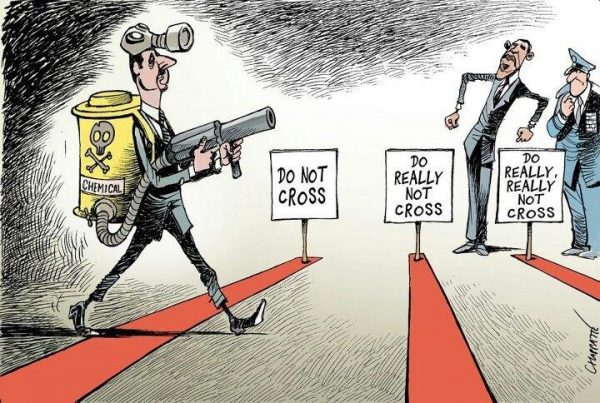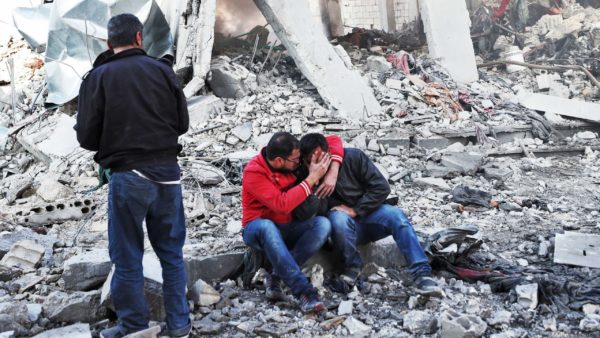Bashar al-Assad is trying to reclaim Idlib, the last rebel stronghold. Millions of civilians are paying the price.
By Jen Kirby

Maher Daboul tries to collect money to help, however he can, the people who have fled, who camp under trees or live in makeshift tents. He writes, too. He does this because he wants to complete his novel before something bad happens.
The fear that something bad will happen is ever-present in Idlib, now the last opposition-held province in Syria. The Syrian regime led by Bashar al-Assad, backed by Russia in the air and pro-Iranian militias on the ground, is laying siege to the province in an attempt to take it back.
This is creating an unfathomable humanitarian catastrophe. Idlib is the center of one of the worst refugee crises in the entire nine-year Syrian civil war.
Daboul, 25, spoke to me via WhatsApp from Aqrabat, Syria, a small village in Idlib province (or governorate) close to the Turkish border in northwestern Syria. (There is also a city of Idlib, which is the province’s capital.) Daboul and his family used to live in Aleppo, but now he is one of about 3 million people in Idlib. About half of Idlib province’s current population came there from other parts of Syria, displaced and uprooted by the civil war.
Now, hundreds of thousands must flee again — some for the third, fourth, or even 10th time. The United Nations estimates that violence in Idlib has displaced at least 900,000 people since December 1, 2019, though it’s likely as high as 1 million by now.

Burak Kara/Getty Images
All of these civilians, most of whom are women and children, are packing into an ever-shrinking area closer and closer to the border with Turkey. That border is sealed. Turkey, which already hosts nearly 4 million Syrian refugees, will not take anymore. Those who try to cross risk being shot.
Dire conditions are compounding the situation. It is the middle of winter. There has been snow in parts of Idlib, and temperatures have dipped below freezing in recent days. Villages in the province are overwhelmed. Many are small to begin with and lack the capacity to house or host so many people. Daboul said a few hundred people used to live in Aqrabat. Now, he says, the number is closer to 10,000. And around it, so many camps.
Families are doubled and tripled up and crammed together into rooms or houses. The rest are forced to take shelter in tents, or under trees, exposed entirely to the weather.
“People are living seven families are living in one house — those who are lucky to live in a house. Many are living in tents; now there aren’t even enough tents. People are living out in the open,” Elizabeth Tsurkov, a fellow in the Middle East program at the Foreign Policy Research Institute, told me. Tsurkov has written extensively on Syria and Idlib, specifically, and helped me get in touch with some people on the ground there for this story.
People like Omar Al-Hiraki, a surgeon at the Bab Al-Hawa Hospital in northwestern Syria, who told me that his hospital saw two children who had died from freezing temperatures. They are likely not the only ones. Without electricity, without heat, people do what they can to keep warm; one family was reportedly asphyxiated after a father brought a gas heater inside a tent, without proper ventilation.
“The loser from this war is civilians,” Al-Hiraki said.
And then there is the reason people are fleeing in the first place: the ongoing assault from Assad’s army and an indiscriminate bombing campaign, led by Russia. Once rebel-held territory has fallen back into Assad’s control, those who lived there often face arrest, conscription, torture. Aerial attacks continue to kill and maim. Al-Hiraki’s hospital treats those injured, the vast majority of them civilians. Syrian and Russian bombs have also targeted hospitals, which means facilities like Al-Hiraki’s and a small number of field hospitals must meet a colossal and overwhelming need.
“These refugees [are] being squeezed from both sides, not being allowed into Turkey, and not gaining any sort of respite from the Syrian government,” Jasmine El-Gamal, a nonresident senior fellow at the Atlantic Council, told me. “And just — I mean, you don’t even want to say it out loud. But, winter is here, they have nowhere to go, and you’re just going to see a lot more people die.”
None of this is shocking, either. This is exactly what many Syria watchers predicted would happen in 2018, before Turkey — which backs some of the rebels in Idlib — and Russia, which backs Assad, agreed to a ceasefire deal that averted the immediate crisis.
That agreement began unraveling in the spring of 2019, and though Turkey and Russia tried to revive the de-escalation agreementover the summer, none stuck. By the end of last year, Assad had renewed his push.
Turkey and Russia are engaged in diplomatic talks right now, but so far the prospects of reaching an agreement to avert the humanitarian disaster, let alone broker a long-term solution, looks grim.
Which is why those caught in Idlib, and experts who closely watch the conflict, cannot really know what the outcome will be, or how much worse the scenario in Idlib might get.
Idlib is the culmination of the brutal, chaotic Syrian civil war
Syrian dictator Bashar al-Assad responded to protests against his government in 2011 with brute force. That transformed the Syrian demonstrations into an open armed conflict between the opposition and the Syrian government.
That conflict spiraled out from there as rebel groups splintered, and jihadist groups, including an al-Qaeda offshoot and ISIS, rose up and took advantage of the chaos.
The war also drew outside parties in: notably Russia, which intervened in 2015 on behalf of the Syrian regime, and Iranian-backed militias that also supported Assad.
On the other side was Turkey, which backed the Syrian opposition, and would use its own military in Syria to help defeat ISIS, and also to push back the Kurds, who eventually became Washington’s preferred ally in the fight against ISIS, much to Turkey’s ire.
As for the United States, then-President Barack Obama was reluctant to intervene in the Syrian war (recall that “red line”). The US eventually carved out a narrow mission — continued and strengthened by the Trump administration — to oust ISIS in partnership with the Syrian Kurds. (Trump threw this effort into confusion last October after he ordered US troops out of northeastern Syria. Turkey invaded to push back the Kurdish presence.)

Russia’s intervention in 2015, along with support from Iran, bolstered a flailing Assad, swinging the war in his favor as he executed a brutal campaign that included chemical attacks on his own people. Backed up by air power and military hardware, the Syrian leader began retaking territory lost to Syrian rebels during the war.
In 2016, Assad reclaimed the rebel-held portion of Aleppo, a major turning point. In the spring of 2018, Assad reasserted control over Eastern Ghouta, a strategic suburb outside Damascus, the capital.
In each of these offensives, Assad followed a “siege, starve, and surrender” strategy, as experts put it to Vox’s Alex Ward. Assad’s forces would overwhelm these rebel strongholds and attack markets, schools, and even hospitals to make the situation untenable, not just for combatants, but for all civilians.
As Assad pursued this strategy in places like Aleppo and Ghouta, his government would give those trapped a choice to try to survive there, or leave. Civilians couldn’t stay in these territories newly reclaimed by the regime, or go to other government-held areas, or they’d likely face arrest or punishment or death.
So there was another option: evacuate on convoys of green buses that would take fighters and their families to another part of Syria still under rebel control. Many of these green buses ended up in Idlib.
“Idlib became the last resort for everyone who fled areas that the regime retook,” Sahar Atrache, senior advocate for the Middle East at Refugees International, told me. This is why the population of Idlib swelled from 1.5 million to more than 3 million today.
And now, there is nowhere else for these millions of people to go. In Assad’s view, Idlib’s civilians, many of them women and children, are now all part of the opposition. Marked, in a way, just by being in Idlib.
So in September 2018, Assad prepared to move on Idlib and finally dismantle the last major opposition holdout.
The last-minute deal that merely delayed — and maybe even deepened — the Idlib catastrophe
A last-minute deal in September 2018 between Turkey and Russia postponed Assad’s plans. Turkish President Recep Tayyip Erdoğan and Russian President Vladimir Putin held a summit in Sochi to finalize the deal, which created a “de-escalation zone,” basically a 15- to 20-kilometer buffer between rebel and pro-government forces.
Turkey would be in charge of separating anti-government rebels from extremist fighters, the biggest being a group called Hayat Tahrir al-Sham — a rebranded al-Nusra, which was al-Qaeda’s spinoff in Syria. It would also help open access to key roadways in the region.
The agreement largely averted the immediate threat of the offensive on Idlib, and the humanitarian crisis that would have ensued. But many observers saw the deal as shaky and tough to implement — especially the parts about Turkey somehow uprooting these jihadist groups and Assad agreeing to basically ignore a territory outside of his control.
As tenuous as this agreement was, it did hold until about the spring of 2019. Russia, especially, began to grow impatient with Turkey, which was either unable or unwilling to disarm these terror groups.
Assad, with Russia’s help, resumed the offensive to retake Idlib by force — part of a larger push to recapture all Syrian territory out of his control. Starting in the south of Idlib province, the Syrian regime used air raids and bombings to attack villages. The death toll began to mount, and thousands of civilians began to flee deeper into Idlib to avoid air raids. Moscow and Ankara did not entirely give up their diplomatic efforts to try to halt the fighting, but any ceasefire deals were short-lived.
“Russia and Turkey have been at it, they’ve been trying to come up with some kind of an agreement over many, many months on the issue of Idlib,” said Mona Yacoubian, senior adviser for Syria, Middle East, and North Africa at the United States Institute of Peace. “Now it appears to have come to a head as the Assad regime has underscored its intentions to take [Idlib].”
Idlib and the surrounding areas are strategically and symbolically critical for Assad. The Syrian regime has “been very clear it will not stop until it has regained every inch of Syria that it can regain,” El-Gamal said. “And Idlib is by far one of the most important.”
Opposition and jihadist forces in Idlib had controlled parts of the M5 highway since about 2012, a vital north-south roadway that links Syria’s major cities. Yacoubian likened Syria’s M5 to the I-95 corridor that runs down the East Coast of the United States. (Turkey was supposed to help secure its opening as part of the ceasefire agreement, another reason it broke down.)
Just this month, Assad has largely regained control, which put him one step closer to consolidating control over the country. “It would open up Syria in terms of trade and transport, which they desperately need because their economy is on the brink of collapsing,” David Lesch, a Syria expert and professor at Trinity University in San Antonio, Texas, told me. He said it’s possible that regaining control of the major arteries and boxing Idlib in, might be enough for Assad to scale back his campaign of civilian bombings — but never a guarantee.
And the reason it is not a guarantee is because of what Idlib represents in the Syrian civil war. It is the last holdout of opposition after nine years of fighting. For Assad, Idlib’s defeat “would be the nail in the coffin for the rebel groups and for the opposition as a whole,” El-Gamal said.
She added that it would send a message to Syrians “that if you have a shred of a doubt that you will defeat me — Assad, this regime — then think again, because I have not stopped at anything.”
What taking Idlib at all costs might mean
Assad has escalated his offensive since November and December 2019.
Al-Ikhlas Hospital, in southern Idlib, was bombed out of existence in November. About 20 people were killed in an air raid in a vegetable market in January. The White Helmets, a volunteer emergency organization in Syria, has documented more than 2,200 airstrikes since the beginning of this year, including 32 cluster bomb attacks and 605 barrel bombs in Idlib, along with Aleppo and Hama. Nearly 400 people have been killed. About a dozen schools and markets have been targeted, along with mosques, roads, and bakeries.
“These are really people they are not interested in saving,” Sara Kayyali, Syria researcher at Human Rights Watch, told me. “Their ideal situation is to sort of end Idlib.”
She added that it’s particularly dangerous because so many of these people are displaced from other areas of Syria and are now all trapped in one place. “And now [they’re] going to bomb this one place to smithereens,” she said.
This intensification has accelerated the mass displacement of those within Idlib, Tskurov told me. “Rebel lines have collapsed, and people do not want to be caught alive by the regime,” she said.
People who are caught are killed, or taken to prison, where they face torture, or simply disappear. The United Nations, in 2016, called it a state policy of “extermination.”
“To be honest, no one will be surrender to Bashar al-Assad,” Omar Al-Hiraki, the surgeon in Syria, told me. This is the desperate, impossible trap that literally hundreds of thousands in Idlib face: die by Assad’s army, or escape and face harsh conditions and a shut-down Turkish border.
“So many people hope to die under the rubble other than being arrested alive with Bashar al-Assad,” he said.
Is there any way to stop this humanitarian tragedy?
While this nightmare is unfolding in Syria, Turkey and Russia are still shuttling back and forth to try to reach an agreement. But all the conditions that made the 2018 ceasefire fail largely still exist — and Assad has gained far more ground.
Turkey has increased its presence in or around northwestern Syria to provide defense and support to the rebels it still backs. Turkish president Erdoğan is trying to revive the outlines of the 2018 deal but has made no secret that he’s been rebuffed by Moscow.
Turkey’s main interests in Syria writ large are to prevent the Kurds from gaining ground — which is mostly separate from the situation in Idlib right now — and to prevent any more refugees from flooding across its border. Turkey already hosts about 3.6 million refugees. Erdoğan is under increasing pressure because Turks are becoming increasingly angry about their presence, and are beginning to cast them as scapegoats for high unemployment and the country’s struggling economy.
So Turkey has anti-government rebel groups to try to fight Assad’s advance and to help control the border. Turkish forces and Syrian troops have scuffled, and tensions are intensifying as at least 16 Turkish troops have been killed in attacks by Syrian government forces.
Turkey is also wary about provoking Russia and about the risks of an all-out conflagration between two powers. Russia, too, doesn’t want to isolate Turkey: Beyond Idlib, Turkey still has a role to play in Syria. And even though they’re on opposite sides in Syria right now, Moscow and Ankara have grown closer in the past year — something Russia is eager to maintain as it drives a nice little wedge between Turkey and its NATO allies, especially the US.
This is the geopolitical impasse that has pushed Syrians in Idlib to the brink. “We don’t know what will happen because the future of this region really depends on the decisions of Erdoğan and Putin personally,” Tsurkov told me.
Erdoğan has amped up his rhetoric in recent days, telling parliament last week that “an operation in Idlib is imminent.”
“We are counting down, we are making our final warnings,” he said.
Yacoubian told me that Erdoğan may be engaged in a little saber-rattling here, but his rhetoric has been consistent and isn’t unserious — it’s not as if he hasn’t followed through on his threats before, especially in Syria.
Erdoğan is not naive, either: If he launched a ground operation to directly challenge Syria, it could rope in Russia. A bloody clash between those two countries would make a humanitarian situation at its breaking point even more dire. But, Yacoubian, said, “the stakes for Turkey in this are nothing less than existential.”
“Maybe as many as 1 million Syrians are on the move and pushing up against the Turkish border,” she added. “Erdoğan cannot afford, in his words, to admit any more refugees.”
Erdoğan said over the weekend that Turkey will meet with Russia, along with leaders from France and Germany, on March 5 to discuss the situation in Syria. But a lot can happen in that time, and millions of civilians who are caught in Idlib will face the consequences.
“It was always clear to me that the endgame was the Syrian government launching an offensive supported by Russia to retake Idlib, and I still think that’s probably what the endgame is going to be,” Lesch said. The question is “what can they do militarily to find a negotiated way out of this that save some face and some level of influence.”
As for the rest of the world, well there’s been a lot of condemnation but little action. The United States and many of its allies are largely on the sidelines, with limited leverage. Russia (and Iran and Syria) and Turkey are the kingmakers in Syria, a consequence of the United States’ desire across two administrations to limit its role in Syria to a narrow counterterrorism mission.
After a Security Council meeting Wednesday, United Nations Ambassador Kelly Craft wrote on Twitter, in a message to the people of Idlib, that “the United States will not spare any effort to deliver the relief, the resources, and, ultimately, the peace that has been kept from you for far too long. We cannot allow today’s headlines to define Syria’s future.”
But it was clear in October, when Trump pulled US forces out from northeastern Syria, giving Turkey the go-ahead to invade, that the White House wants to leave Syria to others to figure out. The US’s continued strict limits on refugees, including those from Syria, doesn’t exactly send a message the US won’t “spare any effort.”
Assad has “won,” but there is no end for Syrians
Daboul saw the bombing of Aleppo when he lived there. He has seen fighting, he has seen people in camps, in tents. He has worked for aid organizations, including in Turkey, where he saw his fellow Syrians forced to relocate there. Back in Syria now, it is, altogether, too much.
So he writes, to discharge and express his feelings, to help him accept the bad conditions. He doesn’t use real people, or their personal stories — it wouldn’t be right, he says — but he “can use the feeling.”
Tsurkov said that if Turkey were to open its borders now, all of Idlib would be there in a matter of days. But as they remain closed, people are confined to an ever-shrinking area, as Assad closes in.
“We’ll basically see either large-scale massacres or large-scale arrests, and then people will be tortured to death in detention, or we will see a massive refugee outflow into Turkey,” Tsurkov said.
The United Nations has called for an end to the fighting and for all sides to “respect the rules of war.” The UN has also called on neighboring countries to admit more refugees. The need for shelter and basic necessities and care is overwhelming.
“Let me be clear,” UN High Commissioner for Refugees Filippo Grandi said in a statement last week: “as humanitarian agencies, we are striving to save lives, but the space for these efforts is shrinking. In the face of such suffering, humanitarian aid alone cannot be the answer.”
Humanitarian aid groups are well-represented across the border in Turkey but have very limited access to Idlib because it’s so volatile. They rely on local partners in Idlib, but those efforts are also victims of Assad’s advance.
“We can’t think about the future, or about today. Sorry, tomorrow,” Huzayfa al-Khateeb, a radio reporter and volunteer who was displaced from Western Ghouta in 2016 and now lives in Idlib City, said on a conference call hosted Wednesday by Refugees International. “I can’t think about what I will do tomorrow because I live the minute now. There [are] no choices.”
VOX

Leave a Reply
You must be logged in to post a comment.